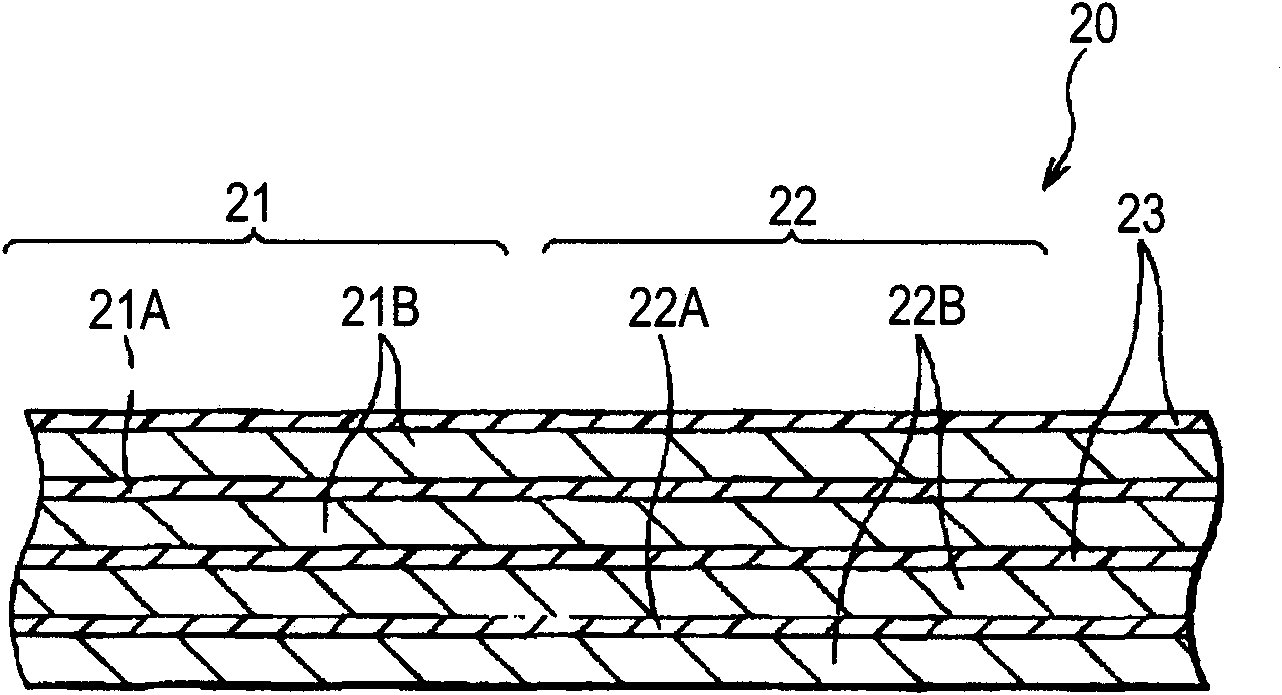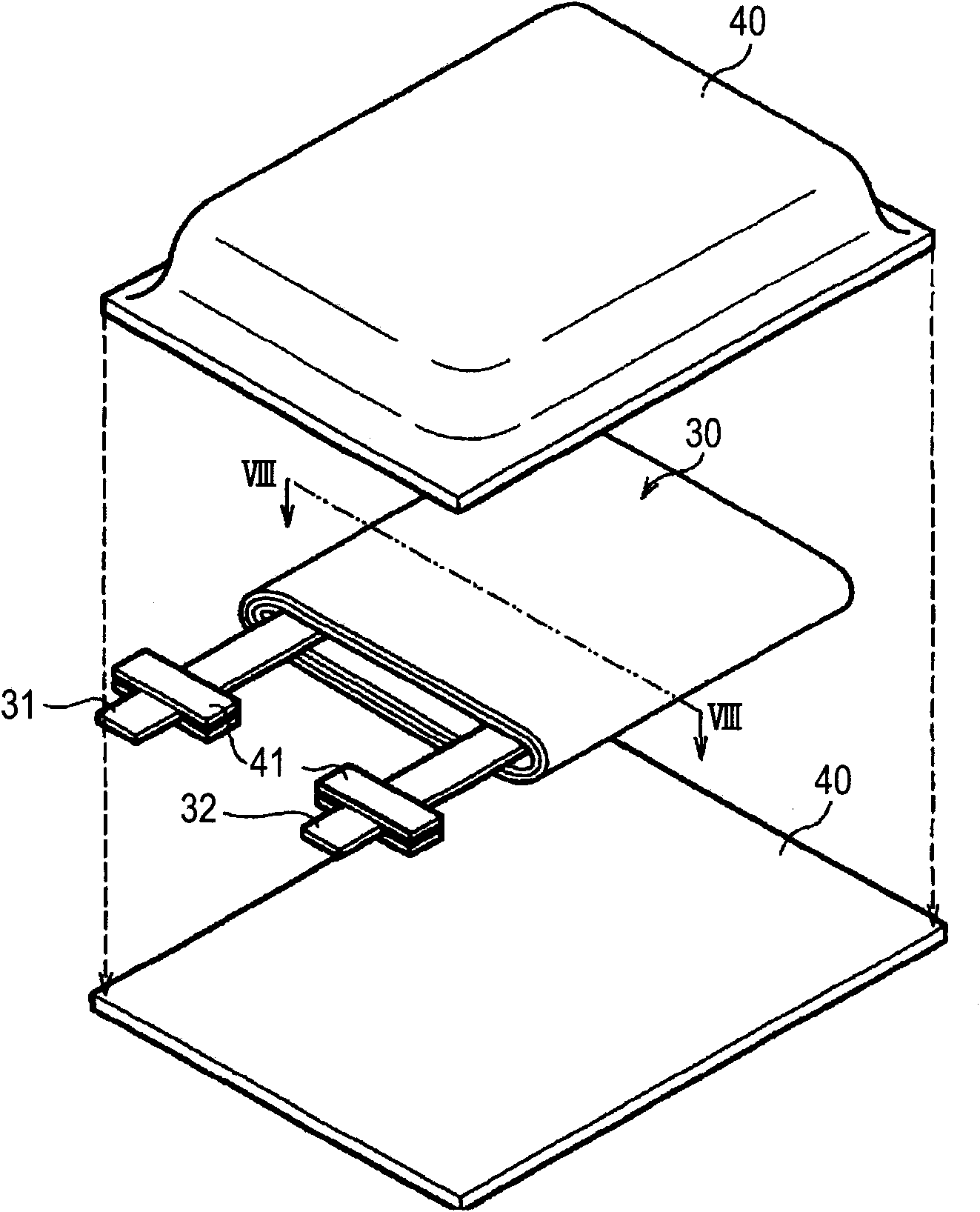Battery
A secondary battery, electrolyte salt technology, applied in secondary batteries, circuits, electrical components, etc., can solve problems such as damage to battery characteristics, poor conductivity, and increase in battery internal impedance, and achieve good high temperature characteristics and cycle characteristics, high Energy density, corrosion inhibition effect
- Summary
- Abstract
- Description
- Claims
- Application Information
AI Technical Summary
Problems solved by technology
Method used
Image
Examples
no. 1 approach
[0066] figure 1 A cross-sectional structure of the secondary battery according to the present embodiment is shown. Such a secondary battery is a so-called lithium ion secondary battery using lithium (Li) as an electrode reactant, in which the negative electrode capacity is expressed as a capacity component due to intercalation and deintercalation of lithium. This secondary battery is of a so-called cylindrical type, and has a wound electrode body 20 having a pair of strip-shaped positive electrodes 21 and strip-shaped negative electrodes 22 inside a substantially hollow cylindrical battery case 11 with a separator interposed therebetween. 23 while winding. The battery case 11 is made of, for example, nickel-plated iron, and one end thereof is closed and the other end is open. Inside the battery case 11 , a pair of insulating plates 12 and 13 are vertically arranged respectively with respect to the wound outer peripheral surface so as to sandwich the wound electrode body 20 ....
no. 2 approach
[0113] image 3 The structure of a secondary battery according to a second embodiment of the present invention is shown. This secondary battery is called a so-called laminated film type, and accommodates a wound electrode body 30 having a positive electrode lead 31 and a negative electrode lead 32 mounted therein inside a film-shaped exterior member 40 .
[0114] Both the cathode lead 31 and the anode lead 32 are drawn out in the same direction, for example, from the inside to the outside of the exterior member 40 . Both the cathode lead 31 and the anode lead 32 are made of a metal material such as aluminum, copper, nickel, stainless steel, etc., and are formed in a thin plate shape or a network shape.
[0115] The exterior member 40 is made of, for example, a rectangular aluminum laminated film obtained by sequentially bonding a nylon film, an aluminum foil, and a polyethylene film. In the exterior member 40 , for example, a polyethylene film side is disposed opposite to th...
Embodiment 1-1 to 1-5
[0129] prepared as figure 1 secondary battery shown.
[0130] First, 94 parts by mass of lithium-cobalt composite oxide as a positive electrode active material, 3 parts by mass of ketjen black (amorphous carbon powder) as a conductive agent, and 3 parts by mass of polymer Vinyl difluoride was mixed, and the mixture was dispersed in N-methyl-2-pyrrolidone as a solvent to prepare positive electrode mixture slurry. Subsequently, this positive electrode mixture slurry was uniformly coated on both surfaces of a positive electrode collector 21A made of a strip-shaped aluminum foil having a thickness of 20 μm, dried, and then press-molded to form a positive electrode active material layer 21B. Thus, the positive electrode 21 was prepared. Thereafter, a cathode lead 25 made of aluminum was attached to one end of the cathode current collector 21A.
[0131] The negative electrode 22 was prepared in the following manner. First, 90 parts by mass of graphite powder as a negative electr...
PUM
| Property | Measurement | Unit |
|---|---|---|
| Thickness | aaaaa | aaaaa |
Abstract
Description
Claims
Application Information
 Login to View More
Login to View More - R&D
- Intellectual Property
- Life Sciences
- Materials
- Tech Scout
- Unparalleled Data Quality
- Higher Quality Content
- 60% Fewer Hallucinations
Browse by: Latest US Patents, China's latest patents, Technical Efficacy Thesaurus, Application Domain, Technology Topic, Popular Technical Reports.
© 2025 PatSnap. All rights reserved.Legal|Privacy policy|Modern Slavery Act Transparency Statement|Sitemap|About US| Contact US: help@patsnap.com



